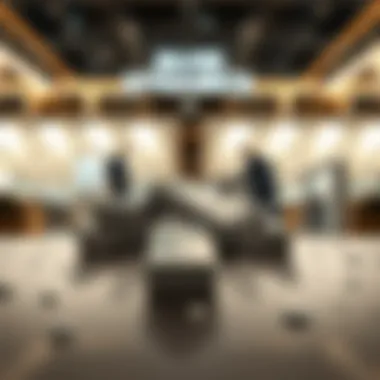Dynamics of Silver Prices in Dubai: A Comprehensive Study


Intro
The thrills and spills of trading in precious metals, especially silver, can create a rollercoaster of emotions for investors and consumers alike. In Dubai, where the glimmer of silver is almost ubiquitous, from the traditional souks to high-end boutiques, understanding silver's price dynamics is crucial. This article aims to peel back the layers of complexities surrounding the market price of silver, particularly per gram in this vibrant emirate. By examining the intertwined factors that influence these prices, including local demand, global trends, and economic implications, we can gain a more robust portrait of Dubai's silver market.
Market Trends
Current Market Analysis
As of late 2023, the silver market in Dubai exhibits a tapestry woven from various economic threads. Prices fluctuate significantly, influenced by global commodity trends, currency shifts, and local buying habits. Currently, silver per gram is trading at about 2.70 AED, a figure that reflects a mild uptick compared to previous months. This rise is not merely by chance; it's a reflection of factors such as inflation, changes in mining output, and shifts in jewelry demand during festive seasons like Ramadan.
Local jewelers often report a noticeable increase in foot traffic during these times as people seek to purchase gifts or adornments. Furthermore, the consolidation of silver imports from countries like China helps maintain a steady supply, vital for keeping prices competitive. Import tariffs and local policies can also play crucial roles, making it imperative for investors to stay informed about regulatory changes that might affect market stability.
"Understanding price fluctuations in silver isn't just about watching the charts; it’s about being attuned to global and local rhythms."
Future Projections
Looking forward, analysts anticipate that the silver market in Dubai will continue to be volatile, yet suppressively resilient. Several indicators suggest that as more investors seek safe havens amidst economic uncertainty, the demand for silver may peak, pushing prices higher. Furthermore, advancements in technology can bolster industrial demand for silver in electronics and solar energy, thus broadening its market footprint.
Economic forecasts project that by 2025, silver prices could breach the 3.00 AED per gram mark if current trends persist. As such, it becomes imperative for investors and consumers to remain prudent in their buying decisions and strategies. Keeping an eye on global economic indicators, currency performance, and even the geopolitical climate will be essential for predicting future price movements.
Investment Strategies
Types of Properties to Consider
Investing in silver, particularly in places like Dubai, isn't just about trading bars or coins. It's also about understanding the various properties available – from physical silver to financial instruments like ETFs. Many savvy investors opt for silver bullion or coins due to their intrinsic value and liquidity. Additionally, considering options like silver mining stocks can offer a way to benefit from the underlying commodity's price movements without the physical overhead.
Prospective investors should also explore local silver dealers or marketplaces, ensuring they understand the authenticity of the products and the premiums charged.
Financing Options and Tips
When it comes to financing investments in silver, numerous avenues are available. Investors might consider options like:
- Personal Loans: Often provide quick access to funds for purchasing silver.
- Margin Trading: Involves borrowing funds to increase buying power, but comes with heightened risks.
- Savings Plans: Consistent savings can gradually build a silver portfolio without overstretching finances.
In addition, it's advisable to consult with financial advisors who specialize in precious metals. They can provide invaluable insights tailored to individual financial situations, helping to craft a strategy that enables both sustainable investment and risk management.
For investors wanting to explore the local market further and stay ahead, resources from financial institutions like the Central Bank of UAE or the Dubai Multi Commodities Centre can be very insightful. Stay updated by checking sites such as Wikipedia, Britannica, and Reddit where communities often share tips and market insights.
Understanding Silver as a Commodity
Silver holds a unique position in the world of commodities, acting not only as a tangible asset but also a cultural symbol and investment vehicle. In Dubai, a hub of trade and commerce, the intricacies of silver pricing are influenced by an amalgamation of global trends and local market demands. Understanding silver as a commodity extends beyond mere economics; it encapsulates historical, cultural, and financial elements that are pivotal to investors, consumers, and traders alike.
Silver's role in industry surges annually, often finding itself in demand for applications ranging from electronics to pharmaceuticals. Investors view silver not just as a way to diversify their portfolios, but also as a hedge against inflation and currency fluctuations. Given Dubai's strategic location, the city acts as a critical nexus where international prices and local values converge. As such, knowing how silver functions as a commodity equipped with both intrinsic and utilitarian value is paramount for anyone looking to navigate the market successfully.
The silver market's dynamics can also fluctuate based on seasonal factors and regional celebrations. For example, during Eid or wedding seasons, the demand spikes as silver is frequently purchased for gifts and jewelry. Moreover, the global shifts in investor sentiment can cause ripples here, intertwining Dubai's local market with broader, international trends. Understanding these layers of silver's identity helps not only in making informed purchases but also in recognizing potential investment opportunities.
The Significance of Silver
Silver’s significance stretches across various sectors. In the jewelry market, it holds a special place due to its aesthetic appeal and workability, attracting consumers who appreciate beauty and craftsmanship. Additionally, silver’s affordability compared to gold makes it a more accessible option for a wider audience. But its significance does not end there. Industrial applications such as solar energy and electronics manufacturing are driving further demand, cementing its status as a vital commodity.
Silver also plays a role in financial markets, where it is traded as futures and options. This provides investors with opportunities to speculate on future movements in prices without needing to physically possess the metal. As analysts parse through economic indicators, the interplay of inflation rates, currency stability, and geopolitical events can signal shifts in silver prices, ultimately influencing how investors approach this precious metal.
Historical Context of Silver Trading
The trade of silver has deep historical roots, tracing back thousands of years. In ancient civilizations, silver coins were synonymous with wealth and prestige, often linked to trade routes and economic policies. The significance of silver was not merely transactional; it held cultural importance and was frequently used as a medium for art and ornamentation.
In modern contexts, the dynamics have evolved significantly. The industrial revolution marked a notable shift in silver trading patterns. The advent of mining technologies increased silver supply, which influenced market prices heavily. In Dubai, the presence of prominent gold and silver souks illustrates the ongoing legacy of silver trading. These marketplaces remain vital, serving both local and international clientele, while allowing for vigorous price negotiation and competition.
While gold often steals the spotlight in precious metals discussions, silver continues to shine brightly because of its multifaceted significance, balancing between investment asset and industrial necessity.
As we navigate the complexities of silver in today’s market environment, the historical context remains a cornerstone of understanding current trends and future possibilities.
Current Silver Prices in Dubai
The current prices of silver in Dubai are more than just figures on a display board; they are a reflection of multiple layers of market dynamics that influence not only local investors but also global participants in the silver trade. Understanding these prices provides insights into the local economy, investment potential, and consumer behavior in this bustling marketplace. With Dubai being a central hub for trade, the silver market here has a direct impact on pricing strategies and investment decisions across borders.


Daily Price Trends
Tracking daily silver prices in Dubai is crucial for those actively involved in trading or considering an investment in this precious metal. The daily fluctuations can be attributed to myriad factors including worldwide economic news, shifts in currency values, and local demand patterns specific to Dubai. For instance, if there is a sudden spike in demand for silver jewelry during a local festival, you may observe a corresponding uptick in daily prices.
Here are four key aspects influencing daily price trends:
- Global Market Movements: When international silver prices surge due to geopolitical tensions or financial crises, local prices tend to follow suit, as Dubai is interconnected with global markets.
- Retail Demand: If the shops in the Gold Souk see increased foot traffic, the heightened demand can push prices up, reflecting consumer willingness to purchase silver products.
- Local Economic Sentiment: Economic reports, inflation forecasts, or changes in consumer confidence in the UAE directly affect buying behavior, thus impacting prices.
- Currency Exchange Rates: As the UAE dirham is pegged to the US dollar, fluctuations in dollar strength can influence local silver prices, making it more or less expensive for buyers.
This intricate interplay means daily price trends cannot be viewed in isolation; one must consider broader economic signals to grasp the full context.
Weekly and Monthly Price Analysis
Looking beyond daily rates, a more in-depth analysis of weekly and monthly price trends helps investors spot patterns and make informed decisions over a longer horizon. The weekly analysis often reveals short-term fluctuations influenced by immediate economic events, whereas monthly analysis offers a clearer picture of ongoing trends.
For example, a consistent increase in monthly prices might indicate a strengthening investment demand, as individuals and institutions stockpile silver in anticipation of future price hikes.
Key points to consider in weekly and monthly price analysis include:
- Seasonal Trends: Certain times of the year, such as Eid or the Dubai Shopping Festival, may see increased purchasing and subsequently influence both short-term and long-term price trajectories.
- Technical Indicators: Traders often analyze charts and graphs for trends; patterns from previous weeks can signal potential future movements in silver prices.
- Market Sentiment: Investor confidence levels, driven by market news and global economic analysis, can cause either bullish or bearish tendencies in silver prices over weeks or months.
- Comparative Asset Performance: Monitoring how silver prices are performing relative to gold or other precious metals can provide context to gauge whether silver is a strong investment at any given time.
With a meticulous approach to both daily and longer-term analyses, investors can navigate the complexities of the silver market in Dubai with a clearer view of the road ahead.
Factors Influencing Silver Prices
Understanding the dynamics of silver prices in Dubai isn’t just a matter of checking daily rates. Various elements come into play, shaping the market and influencing pricing decisions. In this section, we'll dissect these factors to provide a clearer picture for investors and consumers alike, delving into specifics like global economic conditions, local demand and supply factors, and underlying governmental policies that mold the silver marketplace.
Global Economic Conditions
The silver market is closely tied to global economic indicators. Changes on the world stage — whether it's economic growth, geopolitical tensions, or even trade policies — can ripple down to affect local prices in Dubai. When economies are robust, industrial demand for silver can surge, pushing prices higher. Conversely, during periods of economic downturn, silver often sees increased investment demand.
For instance, during the recent global pandemic, many saw silver as a safe haven, leading to significant spikes in demand.
"The price of silver is a reflection of global sentiment. It's where investor confidence meets real-world application in industries like technology and healthcare."
Another key point is the dollar's strength. As a commodity priced in U.S. dollars, any fluctuation against other currencies can make silver relatively more or less expensive for buyers in Dubai. If the dollar weakens, silver becomes cheaper internationally, which can drive demand up.
Local Market Demand and Supply
In Dubai, local consumer behavior deeply influences silver prices. The city is known not just for its luxury lifestyles but also for a cultural affinity towards silver, particularly in jewelry. This tradition ensures a steady demand that affects pricing dynamics.
Additionally, the city's status as a trading hub means that silver can be imported from various sources, affecting local supply. If imports are restricted or if local mining activities see interruptions, supply will dwindle, thus impacting prices.
Conversely, an oversupply can lead to price drops, as sellers find themselves competing for buyers. Investors should closely observe these local factors in conjunction with global ones, as the interplay can greatly influence their purchasing and investment decisions.
Government Policies and Regulations
The influence of governmental policies on silver prices in Dubai cannot be underestimated. Policies related to import duties, taxes, and regulations surrounding silver trading can create significant price fluctuations. For instance, the introduction of tariffs on imported silver can raise prices locally, making it more lucrative for local dealers.
Moreover, regulations on the purity and accreditations of silver can also play a role. Buyers in Dubai are particularly sensitive to quality; thus, governmental scrutiny ensures that only top-grade silver enters the market. This creates a level of trust for consumers but can also lead to cost increases if compliance becomes more expensive.
In summary, navigating the silver market in Dubai requires an understanding of these influences. Moving ahead, paying attention to both global dynamics and local specifics will serve as essential for anyone aiming to participate wisely in the silver trading world.
Investing in Silver in Dubai
Investing in silver has become a focal point for many investors in Dubai, especially given the city’s status as a global trading hub. Silver, often viewed as a stable investment compared to other commodities, presents unique opportunities and challenges specific to the Dubai market. The interest in silver not only stems from its industrial uses but also from its cultural significance in the region.
Engaging in silver investment allows investors to mitigate risks associated with inflation and currency fluctuation. In a fast-paced economy like Dubai’s, where global economic conditions can swiftly change, understanding the dynamics of silver investments is crucial. This section provides insights into diverse investment options and the inherent pros and cons of investing in silver within this vibrant market.
Understanding Investment Options
When contemplating silver as an investment in Dubai, a range of choices becomes available. Investors typically can choose between physical silver, such as coins and bars, and financial instruments like futures and ETFs (Exchange-Traded Funds).
- Physical Silver: Investing in silver bullion is a straightforward approach. Coins and bars not only serve as a tangible asset but also as a hedge against economic instability. The Dubai Gold and Commodities Exchange (DGCX) plays a vital role in facilitating such transactions, providing a platform where silver can be bought and sold.
- Silver ETFs: For those preferring liquidity, silver ETFs offer a practical alternative. These funds track the price of silver and are traded on stock exchanges, enabling quick buying and selling without the need for physical storage.
- Futures Contracts: This investment vehicle is suitable for more experienced investors. Futures allow individuals to agree on a price for silver at a later date, which can prove beneficial in a fluctuating market, though it carries higher risk.
Each option has distinct advantages and drawbacks. Understanding these assists investors in aligning their strategies with their financial goals.


Pros and Cons of Silver Investment
Investing in silver, like any financial decision, comes with its share of advantages and disadvantages. Grasping these elements is pivotal for making informed investment choices.
Pros
- Inflation Hedge: Silver often retains value during inflationary periods, thereby preserving purchasing power.
- Industrial Demand: Silver’s widespread use in various industries, from electronics to renewable energy, provides a solid underpinning for its price stability.
- Cultural Relevance: In Dubai, silver jewelry and accessories carry significant cultural value, boosting local demand considerably.
- Affordability Compared to Gold: With gold prices shooting up, silver presents a more accessible entry point for investors looking to diversify their portfolios without breaking the bank.
Cons
- Price Volatility: Silver can be quite volatile, and its price can fluctuate significantly based on market conditions, which can be a concern for risk-averse investors.
- Storage Costs: Holding physical silver entails storage and insurance costs, which can erode profits over time.
- Market Manipulation Risks: The silver market is not immune to manipulation, which may deter some investors due to concerns about price integrity.
"Investing in silver requires a keen understanding of the market dynamics, especially in bustling hubs like Dubai where trends can shift overnight."
Silver Trading Platforms in Dubai
Understanding the landscape of silver trading platforms in Dubai is crucial for anyone looking to buy, sell, or invest in silver. With its status as a global trading hub, Dubai offers a unique snapshot of how silver trading operates, presenting various avenues for both seasoned investors and newcomers. Knowing these platforms can make a tremendous difference in making informed investment choices and maximizing potential profits.
Overview of Local Exchanges
Dubai hosts several local exchanges where silver is actively traded. Dubai Multi Commodities Centre (DMCC) is one of the most significant platforms, facilitating trading in various precious metals, including silver. The DMCC has established itself as a trusted marketplace, ensuring transparency and security in transactions. The presence of multiple local dealers allows investors to compare prices and choose the best option available.
The reputation of a trading platform plays a massive role in investors' confidence. Platforms that adhere to regulations, such as DMCC, attract a considerable number of traders due to their reliability. Moreover, these local exchanges often provide real-time market analysis, trading tools, and various trading options tailored to suit different investment strategies.
It is also essential to consider the transaction fees associated with these exchanges. While Dubai is known for its tax-free environment on personal income, different exchanges might have varying fee structures, which can eat into profits if not understood clearly. Therefore, a thorough investigation of the available exchanges and their respective fees is paramount for making sound investment decisions.
Online Trading Options
The rise of technology has transformed how silver trading operates in Dubai. Today, investors have the option of online trading platforms, which allow for trading silver with just a few clicks. These platforms are often user-friendly and offer extensive resources such as price alerts, market trends, and investment tutorials, aiding both novices and experts.
One notable option is eToro, which offers a platform for trading a variety of assets, including silver. Its social trading feature allows users to interact, share strategies, and even mimic successful traders' moves. This is particularly appealing to new investors who may not have the experience or knowledge to navigate the market independently.
In addition to eToro, there are various dedicated precious metals platforms like GoldSilver or BullionVault, specifically tailored for silver trading. These platforms provide detailed insights into market prices, historical trends, and secure storage options, ensuring that investors are well-equipped to make informed decisions.
However, while online trading offers convenience, it also comes with its challenges. One cannot overlook the potential risks like cyber threats or fraudulent platforms that target unsuspecting investors. It is wise to choose platforms with robust security features and a good reputation. Thus, always verify the platform's licensing and consider reading user reviews before committing to any online trading service.
The online landscape for silver trading in Dubai not only flattens the playing field but also opens up an array of possibilities that traditional methods may lack.
Comparative Analysis: Silver vs. Other Precious Metals
Understanding the positioning of silver in relation to other precious metals like gold, platinum, and palladium offers valuable insights for investors looking to navigate the complex landscape of the commodity market. This comparative analysis shines a light on various elements such as market volatility, investment appeal, and intrinsic value, all of which play a significant role in shaping the dynamics of silver prices in Dubai.
The distinct characteristics of silver, contrasted with its more illustrious counterparts, can help investors determine the best approach for their portfolios. As such, recognizing these differences is not just an academic exercise; it translates directly into practical decision-making for those seeking to invest wisely or maximize returns.
Gold vs. Silver: Market Dynamics
When comparing gold and silver, one must first understand the psychological and financial trends tied to these two metals. Gold often stands in the spotlight with its long-standing reputation as a ‘safe haven’ during economic turmoil. Investors flock to gold when markets are in upheaval, often causing a spike in price. Conversely, silver, known for its volatility, follows a different narrative.
- Liquidity and Investment Purpose: Gold commands a higher liquidity level due to its popularity, while silver attracts those who might be looking for lower upfront costs and higher volatility.
- Industrial Demand: Unlike gold, a significant portion of silver's value stems from its industrial applications, especially in electronics and solar energy. This characteristic can lead to sharp price fluctuations based on market demands in these sectors.
- Price Ratio: The gold-to-silver price ratio often reflects investor sentiment. When the ratio is high, it indicates that silver is undervalued relative to gold, potentially providing a lucrative investment opportunity.
Given these dynamics, investors in Dubai seeking to diversify their assets might lean towards silver when they perceive a favorable climate driven by industrial demand or when they recognize an attractive price ratio relative to gold.
Platinum and Palladium Considerations
Platinum and palladium represent another layer of complexity in the precious metals market. Both metals are primarily used in automotive catalytic converters, making their price dynamics heavily influenced by the vehicle market and environmental regulations.
- Demand Shifts: An increase in sustainable practices and electric vehicle (EV) adoption poses questions about the future demand for platinum and palladium, and thus times of economic change can influence prices dramatically.
- Investment and Speculation: While not as historically favored as a store of value like gold or silver, platinum and palladium have seen speculative investments rise. Their prices can exhibit sporadic surges, providing both risks and opportunities for investors.
- Geopolitical Factors: Global mining operations primarily located in relatively few countries also add a layer of risk. Political instability in these regions can lead to supply shortages, impacting prices adversely.
In summation, while all these metals have unique attributes and market dynamics, understanding their interrelations can significantly inform one’s investment strategy in Dubai’s silver market. Silver may present a middle ground; it balances the stability of gold with the industrial demand akin to platinum, thus making it an intriguing contender for both seasoned investors and newcomers.
Consumer Trends in Silver Purchases
Understanding consumer trends in silver purchases is vital for grasping the nuances of the silver market in Dubai. The region, known for its luxury shopping and opulent lifestyle, sees a distinct dynamic when it comes to how silver is perceived and purchased. Whether individuals are buying jewelry for personal adornment or investing in silver as a financial asset, various factors influence these choices.
Jewelry vs. Investment Purchases


In Dubai, silver jewelry serves not just a decorative purpose but also a cultural one. It often transcends the category of mere fashion, rooted deeply in social traditions and personal expressions. Many buyers prefer silver pieces crafted by local artisans, which are often embellished with intricate designs, showcasing the rich heritage of the UAE.
When it comes to investment purchases, the approach is markedly different. Investors tend to look for stability and potential growth. The fluctuating price of silver, impacted by both global trends and local demand, makes it crucial for investors to stay informed. Here's a quick breakdown of some considerations regarding jewelry versus investment purchases:
- Jewelry Purchases
- Investment Purchases
- Predominantly emotional decisions driven by personal taste and cultural significance.
- Often marked up due to craftsmanship and design, differing from the spot price of silver.
- Seen as a status symbol, particularly during cultural celebrations and festivals.
- Tend to rely heavily on silver's market performance.
- Buyers are often more aware of price trends, focusing on factors like the economic environment and geopolitical issues.
- May include physical silver in forms like coins or bars, which appeal to those investing for the long term.
These two purchasing avenues reflect broader consumer behaviors concerning silver. While the jewelry market thrives on emotion, the investment side is built on analysis and projections.
Cultural Significance of Silver in Dubai
Silver has long been a symbol of wealth and prosperity, but in Dubai, it’s wrapped in layers of cultural significance. Traditional uses of silver range from wedding gifts to family heirlooms, weaving the metal into the fabric of societal values.
In marriage ceremonies, silver is often gifted, forming an essential part of the dowry, showcasing not only the family's wealth but also their status. The consumption of silver during such ceremonies becomes a pivotal custom, enhancing its importance beyond mere aesthetics.
Furthermore, numerous souks (markets) in Dubai serve as hubs for silver trade, where cultural craftsmanship shines. Here, you can find exquisite silver jewelry adorned with precious stones. This intricate craftsmanship represents not just an economic venture but a preservation of culture and heritage.
"In Dubai, the allure of silver transcends its material value, weaving through personal stories, traditions, and community bonding."
With this deep-rooted cultural significance, silver purchases can also vary based on demographic stratifications, including age, origin, and exposure to global market trends. The younger generation may lean toward more contemporary styles, while older generations might favor traditional pieces, suggesting a potential shift in market dynamics over time.
In summary, consumer trends related to silver purchases in Dubai encompass a rich interplay between emotional value in jewelry buying and investment-driven choices reflected in market engagement. Aware of the cultural context, both investors and buyers can better navigate this vibrant landscape in Dubai.
Future Outlook for Silver Prices in Dubai
Understanding the future trajectory of silver prices in Dubai serves as a vital insight for all stakeholders involved in the market. Investors, buyers, and even casual consumers must fully grasp how these prices may fluctuate in the coming months or years. By focusing on predictions and expert insights alongside the potential risks and opportunities, stakeholders can better navigate their choices and strategies.
Market Predictions and Expert Insights
A multitude of factors will influence silver prices in the foreseeable future. Analysts frequently cite key indicators such as inflation rates, currency strength, and global demand as determining variables. Silver is often considered a safe-haven asset, much like gold. Consequently, political or economic instability may lead to increased interest in silver, driving prices upward.
To add some nuance, recent expert predictions suggest that unless drastic global economic shifts occur, silver prices may stabilize within a certain range. According to market analysts from leading investment firms, the average price per gram is anticipated to hover between AED 300 and AED 350 for the next two quarters. This estimation derives from a mixed bag of supply chain adjustments and evolving demand in key markets like China and India.
Nevertheless, it is crucial to note that predictions can be as slippery as an eel. Market sentiment often shifts based on news cycles and economic reports, which can create volatility even in seemingly stable situations. For instance, a spike in industrial demand—particularly from sectors like electronics and solar panel manufacturing—could push prices unexpectedly high.
"Silver prices can react sharply to changes in investor sentiment and industrial demand. Keeping a close eye on expert insights can provide necessary foresight."
Equally important, many experts stress the significance of technological advancements. Innovations in mining and processing could affect silver supply, further impacting pricing dynamics. With emerging technologies potentially streamlining the extraction of silver from lower-grade ores, a newer surge in availability might place additional downward pressure on prices.
Potential Risks and Opportunities
As with investing in any commodity, the silver market is fraught with risks and opportunities. Below are some considerations:
- Supply Chain Disruptions: Any geopolitical tensions or changes in trade agreements can create a ripple effect, affecting silver's availability.
- Economic Conditions: Economic downturns lead to lesser spending on luxury goods and jewelry, directly impacting silver demand from consumers. Conversely, if markets strengthen, buying may spike.
- Inflation: Silver has historically functioned as a hedge against inflation. Thus, if inflation rises, many investors may flock to silver as a protective measure for their portfolios.
On the flip side, opportunities abound for savvy investors. The emerging trend of sustainable investment can create a niche market for ethically sourced silver, appealing to the ever-growing demographic of conscious investors. Moreover, with technological advancements in green energy, the applications for silver may continue to grow, sustaining demand in innovative industrial sectors.
As the sun rises and sets over Dubai, the silver market remains a complex mix of unpredictability and promise. By staying informed and analyzing the intricacies involved in silver trading, market participants can position themselves to take advantage of unforeseen changes in pricing dynamics.
Ending
In synthesizing the various elements central to the dynamics of silver prices in Dubai, it becomes clear that comprehending the intricate web of factors is crucial not only for investors but also for general consumers. The significance of this topic stretches beyond just market mechanics; it encompasses economic implications that ripple through local communities and global economies.
Summary of Insights
This analysis has traversed several critical points regarding silver trading in Dubai. First, we examined how global economic conditions, such as inflation rates or commodity demand, sway the silver market. This context is vital for understanding the broader implications for both buyers and sellers.
Next, we looked at local market dynamics, which include the demand from tourists and expats, as well as cultural inclinations towards silver jewelry—a staple in many households across the UAE.
Moreover, government regulations play a pivotal role in shaping the market landscape, influencing everything from import duties to tax policies. This adds another layer of complexity to the investment climate, one that potential investors should not overlook.
Lastly, we addressed future outlooks, reminding stakeholders that the world of silver investment is not static. With market predictions and expert insights steering awareness about potential risks and opportunities, investors can navigate this landscape more effectively.
Final Thoughts on Silver Investment in Dubai
Though the allure of silver as a safe haven remains strong, it is vital for investors to remain vigilant and informed. To avoid the pitfalls, keeping abreast of market trends and external economic conditions is paramount. Remember, the silver market in Dubai is influenced by both local nuances and global events, presenting a complex but rewarding playing field for those willing to engage.
Ultimately, the value of silver extends beyond its market price; it is a reflection of cultural significance, economic stability, and investment strategy, making it a prominent feature within Dubai's vibrant marketplace.
So, whether you’re planning on purchasing for personal use or considering silver as a part of your investment portfolio, a firm grasp on these aspects will lead to more informed choices. Let this analysis serve as a guiding light through the sometimes murky waters of silver trading in Dubai.



